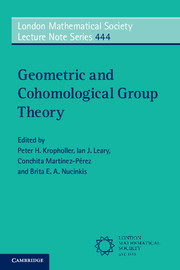Book contents
- Frontmatter
- Contents
- List of Participants
- Preface
- Obstructions for subgroups of Thompson's group V
- Groups of homological dimension one
- Braided diagram groups and local similarity groups
- On Thompson's group T and algebraic K-theory
- Special cube complexes (based on lectures of Piotr Przytycki)
- A hyperbolic group with a finitely presented subgroup that is not of type FP3
- The structure of Euclidean Artin groups
- Finitely presented groups associated with expanding maps
- On characteristic modules of groups
- Controlled algebra for simplicial rings and algebraic K-theory
- References
The structure of Euclidean Artin groups
Published online by Cambridge University Press: 11 October 2017
- Frontmatter
- Contents
- List of Participants
- Preface
- Obstructions for subgroups of Thompson's group V
- Groups of homological dimension one
- Braided diagram groups and local similarity groups
- On Thompson's group T and algebraic K-theory
- Special cube complexes (based on lectures of Piotr Przytycki)
- A hyperbolic group with a finitely presented subgroup that is not of type FP3
- The structure of Euclidean Artin groups
- Finitely presented groups associated with expanding maps
- On characteristic modules of groups
- Controlled algebra for simplicial rings and algebraic K-theory
- References
Summary
Abstract
The Coxeter groups that act geometrically on euclidean space have long been classified and presentations for the irreducible ones are encoded in the well-known extended Dynkin diagrams. The corresponding Artin groups are called euclidean Artin groups and, despite what one might naively expect, most of them have remained fundamentally mysterious for more than forty years. Recently, my coauthors and I have resolved several long-standing conjectures about these groups, proving for the first time that every irreducible euclidean Artin group is a torsion-free centerless group with a decidable word problem and a finitedimensional classifying space. This article surveys our results and the techniques we use to prove them.
2010 Mathematics Subject Classification: 20F36, 20F55Key words and phrases: euclidean Coxeter groups, euclidean Artin groups, Garside structures, dual presentations.
The reflection groups that act geometrically on spheres and euclidean spaces are all described by presentations of an exceptionally simple form and general Coxeter groups are defined by analogy. These spherical and euclidean Coxeter groups have long been classified and their presentations are encoded in the well-known Dynkin diagrams and extended Dynkin diagrams, respectively. Artin groups are defined by modified versions of these Coxeter presentations, and they were initially introduced to describe the fundamental group of a space constructed from the complement of the hyperplanes in a complexified version of the reflection arrangement for the corresponding spherical or euclidean Coxeter group. The most basic example of a Coxeter group is the symmetric group and the corresponding Artin group is the braid group, the fundamental group of a quotient of the complement of a complex hyperplane arrangement called the braid arrangement.
The spherical Artin groups, that is the Artin groups corresponding to the Coxeter groups acting geometrically on spheres, have been well understood ever since Artin groups themselves were introduced by Pierre Deligne [Del72] and by Brieskorn and Saito [BS72] in adjacent articles in the Inventiones in 1972. One might have expected the euclidean Artin groups to be the next class of Artin groups whose structure was well-understood, but this was not to be. Despite the centrality of euclidean Coxeter groups in Coxeter theory and Lie theory more generally, euclidean Artin groups have remained fundamentally mysterious, with a few minor exceptions, for the past forty years.
- Type
- Chapter
- Information
- Geometric and Cohomological Group Theory , pp. 82 - 114Publisher: Cambridge University PressPrint publication year: 2017
References
- 2
- Cited by

